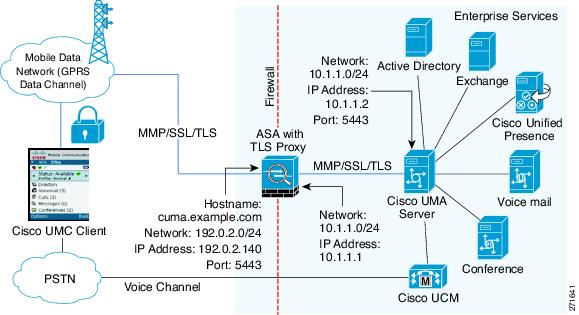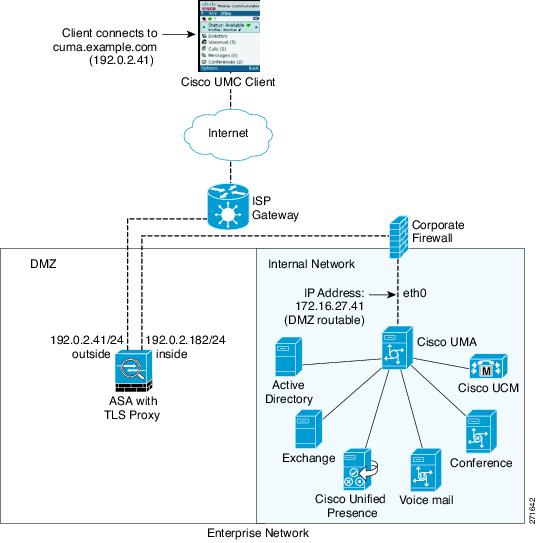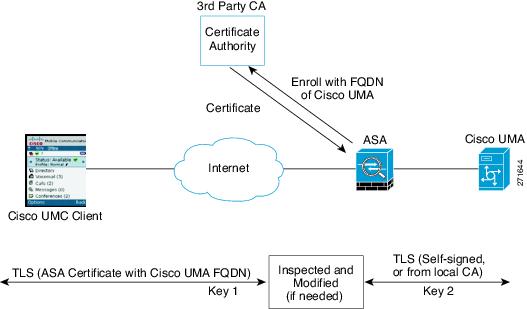- About this Guide
-
- Information About Cisco Unified Communications Features
- Using the Cisco Unified Communication Wizard
- Configuring the Cisco Phone Proxy
- Configuring the TLS Proxy for Encrypted Voice Inspection
- Configuring Cisco Mobility Advantage
- Configuring Cisco Unified Presence
- Configuring Cisco Unified Communications Intercompany Media Engine
- Index
Configuring Cisco Mobility Advantage
This chapter describes how to configure the ASA for Cisco Unified Communications Mobility Advantage Proxy features.
Information about the Cisco Mobility Advantage Proxy Feature
This section contains the following topics:
- Cisco Mobility Advantage Proxy Functionality
- Mobility Advantage Proxy Deployment Scenarios
- Trust Relationships for Cisco UMA Deployments
Cisco Mobility Advantage Proxy Functionality
To support Cisco UMA for the Cisco Mobility Advantage solution, the mobility advantage proxy (implemented as a TLS proxy) includes the following functionality:
- The ability to allow no client authentication during the handshake with clients.
- Allowing an imported PKCS-12 certificate to server as a proxy certificate.
The ASA includes an inspection engine to validate the Cisco UMA Mobile Multiplexing Protocol (MMP).
MMP is a data transport protocol for transmitting data entities between Cisco UMA clients and servers. MMP must be run on top of a connection-oriented protocol (the underlying transport) and is intended to be run on top of a secure transport protocol such as TLS. The Orative Markup Language (OML) protocol is intended to be run on top of MMP for the purposes of data synchronization, as well as the HTTP protocol for uploading and downloading large files.
The TCP/TLS default port is 5443. There are no embedded NAT or secondary connections.
Cisco UMA client and server communications can be proxied via TLS, which decrypts the data, passes it to the inspect MMP module, and re-encrypt the data before forwarding it to the endpoint. The inspect MMP module verifies the integrity of the MMP headers and passes the OML/HTTP to an appropriate handler. The ASA takes the following actions on the MMP headers and data:
- Verifies that client MMP headers are well-formed. Upon detection of a malformed header, the TCP session is terminated.
- Verifies that client to server MMP header lengths are not exceeded. If an MMP header length is exceeded (4096), then the TCP session is terminated.
- Verifies that client to server MMP content lengths are not exceeded. If an entity content length is exceeded (4096), the TCP session is terminated.

Note 4096 is the value currently used in MMP implementations.
Because MMP headers and entities can be split across packets, the ASA buffers data to ensure consistent inspection. The SAPI (stream API) handles data buffering for pending inspection opportunities. MMP header text is treated as case insensitive and a space is present between header text and values. Reclaiming of MMP state is performed by monitoring the state of the TCP connection.
Mobility Advantage Proxy Deployment Scenarios
Figure 18-1 and Figure 18-2 show the two deployment scenarios for the TLS proxy used by the Cisco Mobility Advantage solution. In scenario 1 (the recommended deployment architecture), the ASA functions as both the firewall and TLS proxy. In scenario 2, the ASA functions as the TLS proxy only and works with an existing firewall. In both scenarios, the clients connect from the Internet.
In the scenario 1 deployment, the ASA is between a Cisco UMA client and a Cisco UMA server. The Cisco UMA client is an executable that is downloaded to each smartphone. The Cisco UMA client applications establishes a data connection, which is a TLS connection, to the corporate Cisco UMA server. The ASA intercepts the connections and inspects the data that the client sends to the Cisco UMA server.

Note The TLS proxy for the Cisco Mobility Advantage solution does not support client authentication because the Cisco UMA client cannot present a certificate. The following commands can be used to disable authentication during the TLS handshake.hostname(config)# tls-proxy my_proxy hostname(config-tlsp)# no server authenticate-client
Figure 18-1 Security Appliance as Firewall with Mobility Advantage Proxy and MMP Inspection

In Figure 18-1, the ASA performs static NAT by translating the Cisco UMA server 10.1.1.2 IP address to 192.0.2.140.
Figure 18-2 shows deployment scenario 2, where the ASA functions as the TLS proxy only and does not function as the corporate firewall. In this scenario, the ASA and the corporate firewall are performing NAT. The corporate firewall will not be able to predict which client from the Internet needs to connect to the corporate Cisco UMA server. Therefore, to support this deployment, you can take the following actions:
- Set up a NAT rule for inbound traffic that translates the destination IP address 192.0.2.41 to 172.16.27.41.
- Set up an interface PAT rule for inbound traffic translating the source IP address of every packet so that the corporate firewall does not need to open up a wildcard pinhole. The Cisco UMA server receives packets with the source IP address 192.0.12.183.
See Chapter 4, “Configuring Network Object NAT” and Chapter 5, “Configuring Twice NAT” for information.

Note This interface PAT rule converges the Cisco UMA client IP addresses on the outside interface of the ASA into a single IP address on the inside interface by using different source ports. Performing this action is often referred as “outside PAT”. “Outside PAT” is not recommended when TLS proxy for Cisco Mobility Advantage is enabled on the same interface of the ASA with phone proxy, Cisco Unified Presence, or any other features involving application inspection. “Outside PAT” is not supported completely by application inspection when embedded address translation is needed.
Figure 18-2 Cisco UMC/Cisco UMA Architecture – Scenario 2: Security Appliance as Mobility Advantage Proxy Only

Mobility Advantage Proxy Using NAT/PAT
In both scenarios (Figure 18-1 and Figure 18-2), NAT can be used to hide the private address of the Cisco UMA servers.
In scenario 2 (Figure 18-2), PAT can be used to converge all client traffic into one source IP, so that the firewall does not have to open up a wildcard pinhole for inbound traffic.
Trust Relationships for Cisco UMA Deployments
To establish a trust relationship between the Cisco UMC client and the ASA, the ASA uses the Cisco UMA server certificate and keypair or the ASA obtains a certificate with the Cisco UMA server FQDN (certificate impersonation). Between the ASA and the Cisco UMA server, the ASA and Cisco UMA server use self-signed certificates or certificates issued by a local certificate authority.
Figure 18-3 shows how you can import the Cisco UMA server certificate onto the ASA. When the Cisco UMA server has already enrolled with a third-party CA, you can import the certificate with the private key onto the ASA. Then, the ASA has the full credentials of the Cisco UMA server. When a Cisco UMA client connects to the Cisco UMA server, the ASA intercepts the handshake and uses the Cisco UMA server certificate to perform the handshake with the client. The ASA also performs a handshake with the server.
Figure 18-3 How the Security Appliance Represents Cisco UMA – Private Key Sharing

Figure 18-4 shows another way to establish the trust relationship. Figure 18-4 shows a green field deployment, because each component of the deployment has been newly installed. The ASA enrolls with the third-party CA by using the Cisco UMA server FQDN as if the ASA is the Cisco UMA server. When the Cisco UMA client connects to the ASA, the ASA presents the certificate that has the Cisco UMA server FQDN. The Cisco UMA client believes it is communicating to with the Cisco UMA server.
Figure 18-4 How the Security Appliance Represents Cisco UMA – Certificate Impersonation

A trusted relationship between the ASA and the Cisco UMA server can be established with self-signed certificates. The ASA's identity certificate is exported, and then uploaded on the Cisco UMA server truststore. The Cisco UMA server certificate is downloaded, and then uploaded on the ASA truststore by creating a trustpoint and using the crypto ca authenticate command.
Licensing for the Cisco Mobility Advantage Proxy Feature
The Cisco Unified Communications proxy features (Cisco Phone Proxy, TLS proxy for encrypted voice inspection, and the Cisco Presence Federation Proxy) supported by the ASA require a Unified Communications Proxy license. However, in Version 8.2(2) and later, the Mobility Advantage proxy no longer requires a Unified Communications Proxy license.
The following table shows the licensing requirements for the Mobility Advantage proxy:
For more information about licensing, see the general operations configuration guide.
Configuring Cisco Mobility Advantage
This section includes the following topics:
- Task Flow for Configuring Cisco Mobility Advantage
- Installing the Cisco UMA Server Certificate
- Creating the TLS Proxy Instance
- Enabling the TLS Proxy for MMP Inspection
Task Flow for Configuring Cisco Mobility Advantage
To configure for the ASA to perform TLS proxy and MMP inspection as shown in Figure 18-1 and Figure 18-2, perform the following tasks.
It is assumed that self-signed certificates are used between the ASA and the Cisco UMA server.
Export the Cisco UMA server certificate and keypair in PKCS-12 format so that you can import it onto the ASA. The certificate will be used during the handshake with the Cisco UMA clients.
Step 1 Create the static NAT for the Cisco UMA server by entering the following commands:
Step 2 Import the Cisco UMA server certificate onto the ASA by entering the following commands:
Step 3 Install the Cisco UMA server certificate on the ASA. See Installing the Cisco UMA Server Certificate.
Step 4 Create the TLS proxy instance for the Cisco UMA clients connecting to the Cisco UMA server. See Creating the TLS Proxy Instance.
Step 5 Enable the TLS proxy for MMP inspection. See Enabling the TLS Proxy for MMP Inspection.
Installing the Cisco UMA Server Certificate
Install the Cisco UMA server self-signed certificate in the ASA truststore. This task is necessary for the ASA to authenticate the Cisco UMA server during the handshake between the ASA proxy and Cisco UMA server.
Export the Cisco UMA server certificate and keypair in PKCS-12 format so that you can import it onto the ASA.
Once you have created the trustpoints and installed the Cisco UMA certificate on the ASA, create the TLS proxy instance. See Creating the TLS Proxy Instance.
Creating the TLS Proxy Instance
Create a TLS proxy instance for the Cisco UMA clients connecting to the Cisco UMA server.
Before you can create the TLS proxy instance, you must have installed the Cisco UMA server self-signed certificate in the ASA truststore.
Once you have created the TLS proxy instance, enable it for MMP inspection. See Enabling the TLS Proxy for MMP Inspection.
Enabling the TLS Proxy for MMP Inspection
Cisco UMA client and server communications can be proxied via TLS, which decrypts the data, passes it to the inspect MMP module, and re-encrypt the data before forwarding it to the endpoint. The inspect MMP module verifies the integrity of the MMP headers and passes the OML/HTTP to an appropriate handler.
Monitoring for Cisco Mobility Advantage
Mobility advantage proxy can be debugged the same way as IP Telephony. You can enable TLS proxy debug flags along with SSL syslogs to debug TLS proxy connection problems.
For example, using the following commands to enable TLS proxy-related debugging and syslog output only:
For information about TLS proxy debugging techniques and sample output, see the Monitoring the TLS Proxy.
Enable the debug mmp command for MMP inspection engine debugging:
You can also capture the raw and decrypted data by the TLS proxy by entering the following commands:
Configuration Examples for Cisco Mobility Advantage
- Example 1: Cisco UMC/Cisco UMA Architecture – Security Appliance as Firewall with TLS Proxy and MMP Inspection
- Example 2: Cisco UMC/Cisco UMA Architecture – Security Appliance as TLS Proxy Only
This section describes sample configurations that apply to two deployment scenarios for the TLS proxy used by the Cisco Mobility Advantage solution—scenario 1 where the ASA functions as both the firewall and TLS proxy and scenario 2 where the ASA functions as the TLS proxy only. In both scenarios, the clients connect from the Internet.
In the samples, you export the Cisco UMA server certificate and key-pair in PKCS-12 format and import it to the ASA. The certificate will be used during handshake with the Cisco UMA clients.
Installing the Cisco UMA server self-signed certificate in the ASA truststore is necessary for the ASA to authenticate the Cisco UMA server during handshake between the ASA proxy and Cisco UMA server. You create a TLS proxy instance for the Cisco UMA clients connecting to the Cisco UMA server. Lastly, you must enable TLS proxy for MMP inspection.
Example 1: Cisco UMC/Cisco UMA Architecture – Security Appliance as Firewall with TLS Proxy and MMP Inspection
As shown in Figure 18-5 (scenario 1—the recommended architecture), the ASA functions as both the firewall and TLS proxy. In the scenario 1 deployment, the ASA is between a Cisco UMA client and a Cisco UMA server. In this scenario, the ASA performs static NAT by translating the Cisco UMA server 10.1.1.2 IP address to 192.0.2.140.
Figure 18-5 Cisco UMC/Cisco UMA Architecture – Scenario 1: Security Appliance as Firewall with TLS Proxy and MMP Inspection

Example 2: Cisco UMC/Cisco UMA Architecture – Security Appliance as TLS Proxy Only
As shown in Figure 18-6 (scenario 2), the ASA functions as the TLS proxy only and works with an existing firewall. The ASA and the corporate firewall are performing NAT. The corporate firewall will not be able to predict which client from the Internet needs to connect to the corporate Cisco UMA server. Therefore, to support this deployment, you can take the following actions:
- Set up a NAT rule for inbound traffic that translates the destination IP address 192.0.2.41 to 172.16.27.41.
- Set up an interface PAT rule for inbound traffic translating the source IP address of every packet so that the corporate firewall does not need to open up a wildcard pinhole. The Cisco UMA server receives packets with the source IP address 192.0.2.183.
Figure 18-6 Cisco UMC/Cisco UMA Architecture – Scenario 2: Security Appliance as TLS Proxy Only

Feature History for Cisco Mobility Advantage
Table 18-1 lists the release history for this feature.
 Feedback
Feedback